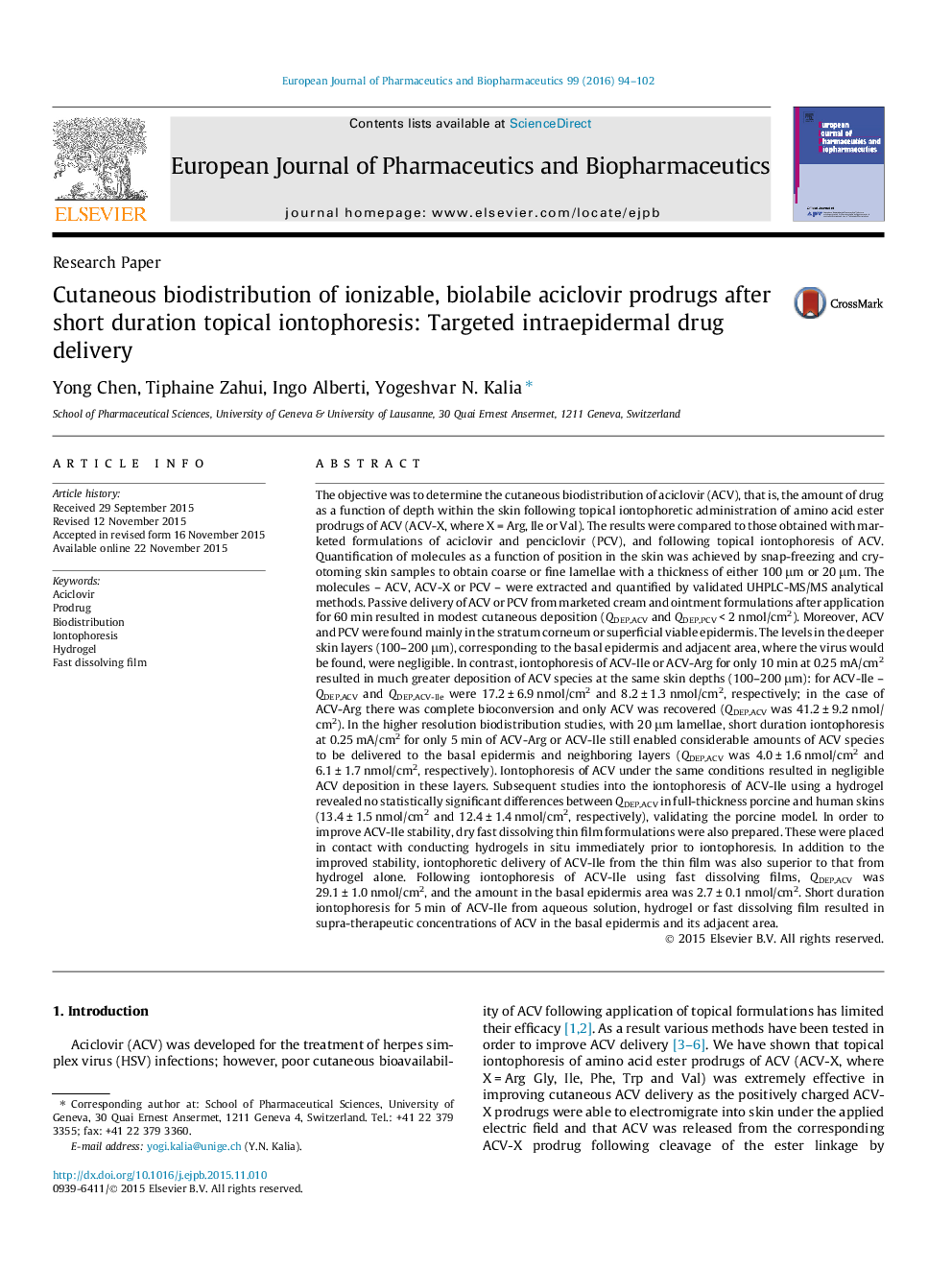| کد مقاله | کد نشریه | سال انتشار | مقاله انگلیسی | نسخه تمام متن |
|---|---|---|---|---|
| 2083396 | 1545324 | 2016 | 9 صفحه PDF | دانلود رایگان |

The objective was to determine the cutaneous biodistribution of aciclovir (ACV), that is, the amount of drug as a function of depth within the skin following topical iontophoretic administration of amino acid ester prodrugs of ACV (ACV-X, where X = Arg, Ile or Val). The results were compared to those obtained with marketed formulations of aciclovir and penciclovir (PCV), and following topical iontophoresis of ACV. Quantification of molecules as a function of position in the skin was achieved by snap-freezing and cryotoming skin samples to obtain coarse or fine lamellae with a thickness of either 100 μm or 20 μm. The molecules – ACV, ACV-X or PCV – were extracted and quantified by validated UHPLC-MS/MS analytical methods. Passive delivery of ACV or PCV from marketed cream and ointment formulations after application for 60 min resulted in modest cutaneous deposition (QDEP,ACV and QDEP,PCV < 2 nmol/cm2). Moreover, ACV and PCV were found mainly in the stratum corneum or superficial viable epidermis. The levels in the deeper skin layers (100–200 μm), corresponding to the basal epidermis and adjacent area, where the virus would be found, were negligible. In contrast, iontophoresis of ACV-Ile or ACV-Arg for only 10 min at 0.25 mA/cm2 resulted in much greater deposition of ACV species at the same skin depths (100–200 μm): for ACV-Ile – QDEP,ACV and QDEP,ACV-Ile were 17.2 ± 6.9 nmol/cm2 and 8.2 ± 1.3 nmol/cm2, respectively; in the case of ACV-Arg there was complete bioconversion and only ACV was recovered (QDEP,ACV was 41.2 ± 9.2 nmol/cm2). In the higher resolution biodistribution studies, with 20 μm lamellae, short duration iontophoresis at 0.25 mA/cm2 for only 5 min of ACV-Arg or ACV-Ile still enabled considerable amounts of ACV species to be delivered to the basal epidermis and neighboring layers (QDEP,ACV was 4.0 ± 1.6 nmol/cm2 and 6.1 ± 1.7 nmol/cm2, respectively). Iontophoresis of ACV under the same conditions resulted in negligible ACV deposition in these layers. Subsequent studies into the iontophoresis of ACV-Ile using a hydrogel revealed no statistically significant differences between QDEP,ACV in full-thickness porcine and human skins (13.4 ± 1.5 nmol/cm2 and 12.4 ± 1.4 nmol/cm2, respectively), validating the porcine model. In order to improve ACV-Ile stability, dry fast dissolving thin film formulations were also prepared. These were placed in contact with conducting hydrogels in situ immediately prior to iontophoresis. In addition to the improved stability, iontophoretic delivery of ACV-Ile from the thin film was also superior to that from hydrogel alone. Following iontophoresis of ACV-Ile using fast dissolving films, QDEP,ACV was 29.1 ± 1.0 nmol/cm2, and the amount in the basal epidermis area was 2.7 ± 0.1 nmol/cm2. Short duration iontophoresis for 5 min of ACV-Ile from aqueous solution, hydrogel or fast dissolving film resulted in supra-therapeutic concentrations of ACV in the basal epidermis and its adjacent area.
Figure optionsDownload high-quality image (150 K)Download as PowerPoint slide
Journal: European Journal of Pharmaceutics and Biopharmaceutics - Volume 99, February 2016, Pages 94–102